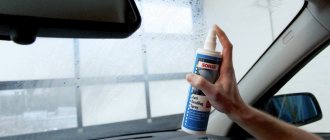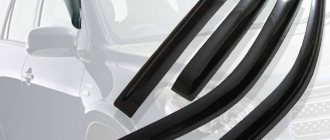One of the tenets of safe driving is good visibility. This is especially true in the off-season and winter, when precipitation and darkness create natural problems for the perception of the situation on the road. And at the same time, motorists most often encounter the problem of glass fogging.
The main reason for windows fogging is temperature differences. In a warmer interior, moisture condenses on the cold windows. Therefore, you can fight fogging by warming the windows and drying the air - often this happens simultaneously.
Here we give some simple tips on how to keep your windows clear.
Correctly set up climate systems
At the first signs of fogging, you need to select the window blowing mode, direct the air flow from the deflectors to the glass and slightly increase the temperature. If your car has air conditioning, it should dry the air in a few minutes. You just need to be sure that the internal circulation mode is turned off. If the climate system does not cope well with heating and drying the air, you need to check the cabin filter - it could have absorbed too much moisture, and in wet weather it does not have time to dry, or it is simply time to replace it.
Methods for solving the problem
When the windows in a car fog up from the inside, what to do is a burning question for many car enthusiasts and professionals. Of course, the easiest way is to wipe away the perspiration, but, unfortunately, this will not solve the problem, which will return again and again if the influencing factors are not eliminated. However, in winter this is what you have to do. Additionally, it is advisable to regularly open the windows, although this is not very pleasant for the people in the cabin. Or wipe the glass and turn on the warm air supply.
As for rainy weather or bad days with wet snow, excess perspiration can be eliminated by several methods:
- Turn on the heating by pointing the radiator shutter at the windshield, while opening the windows slightly. Usually the perspiration disappears very quickly.
- Some drivers open the side windows slightly while driving, and as soon as they stop, they also open the door slightly so that air from the street enters the cabin.
- In the end, you can periodically wipe the glass, and to avoid leaving marks on it that also interfere with your view, it makes sense to use special rags for such purposes - they are made of polyamide or polyester fibers. The fabric has excellent absorbent properties, and the surface remains streak-free.
Understanding why car windows sweat from the inside in winter or in bad weather, it is always easier to imagine what is required to get rid of the problem. And sometimes car windows sweat from the inside in winter due to car malfunctions. This means it’s time to think about eliminating them.
If the issue is an incorrect adjustment of the climate control system , in such a situation the following actions should be taken:
- First, the vents located at the front and bottom are blocked, this helps ensure that the air is directed towards the windshield. Sometimes these holes can be clogged, which is why the windows in the car sweat from the inside in winter. If a compact air conditioner is present, it will also help dry the interior.
- After this, you should start changing the settings; in most cases, the cause of the problem is the heating is not working properly, so you need to turn on the airflow at full power and turn the heater flaps towards the windshield.
Fogging is often caused by other technical faults, so it is important to periodically inspect the car to identify problems. They can be in the following order:
- A common occurrence is contamination of the cabin filter, which is designed to clean the air entering the car through the fan air ducts. It can be clogged with dust, dirt, sand, which leads to obstruction and disruption of its function. In addition, the part may not work correctly due to dampness, and then damp air will enter the cabin.
- An increase in humidity in the cabin can be caused by air intake grilles clogged with road dust particles, damaged ventilation deflectors, a recirculation air valve that is jammed, and therefore the windows in the car sweat from the inside in winter.
In other words, it is necessary to constantly monitor the operation of the heating radiator and fan, as well as other parts related to heating and ventilation equipment.
It is also useful to remember that it is easier to prevent the formation of condensation; in this regard, on the eve of the autumn-winter period, you should thoroughly dry the interior, correct problems related to the technical equipment of the car, remove wet things and clothes from the car, and thoroughly dry the seats and mats .
Treat glass using traditional methods
The problem of fogging arose quite a long time ago, so drivers had time to find several options for window treatment using improvised means. One of the most popular is applying a solution of 1 part glycerin and 10 parts alcohol. If you use only glycerin, the glass will become greasy and at night there will be strong reflections in the stains, impairing visibility. Some people advise wiping windows with newspapers - printing ink contains substances that create the same film as when using auto chemicals. Another tip is to rub the windows with tobacco from regular cigarettes.
To keep the glass from freezing
It helps to cover the inside of the glass with a transparent film. The thermal conductivity of the film is much lower than that of glass, and such a “glazed window” will no longer freeze.
To prevent beautiful frosty patterns from forming on the windows overnight, do not forget to ventilate the interior before leaving the car in the parking lot. To do this, open the windows slightly during the last hundred meters of the journey, and after parking, open all the doors for a few minutes. The temperature of the glass outside and inside will be equalized, because you will release all the warm air from the cabin.
I wish that the windows of your car always remain crystal clear.
- Find out how to set up a ventilation system to prevent windows from sweating here.
- The warm-up time for the interior will be significantly reduced if you cover the engine with a special blanket. To avoid icing on your wipers, install heated blades: various connection options, discounts for a set.
Remove excess moisture from the interior
Advice:
In an extreme situation, open windows can save you from fogging. But after ventilation it will be more difficult to restore the climate balance. Often in winter and in damp weather, water or snow gets inside the car. When the interior begins to warm up, the liquid evaporates and settles on the cold glass. To reduce this effect, excess moisture should be removed. Sometimes you need to remove puddles or ice from the mats, and if there is already a lot of water, put newspapers under your feet and throw them away when they are soaked. If the interior becomes wet even with light rain, you need to check its tightness - a loose seal can be a source of not only increased humidity, but also premature corrosion. There is no need to store rags that were used to wipe wet surfaces in the cabin - put them in the trunk or under the hood. Salt in a paper bag that can be placed in the back seat reduces humidity. The effect will be better if the packaging has been dried in a warm place before.
What is the danger?
- Poor visibility.
Frozen glass prevents you from starting to move for a long time. If the driver did not allow time for warming up the car, then after the glass has warmed up, he begins to drive faster than usual, making up for lost time, and this is dangerous. It also happens: you warmed up the car, the glass seems to have thawed, everything is visible. You drive out of a shady courtyard onto a street flooded with sunlight, and the glass turns into a white screen due to the abundance of glare. The situation is extremely dangerous. - Antifreeze fumes.
Foggy windows can be caused by a leak from the heater core.
In this case, the driver and passengers risk inhaling antifreeze vapors
. There is an unpleasant sweetish smell in the cabin. And even after eliminating the malfunction, it will be difficult to clean the glass from the oily film. - When the humidity in the cabin is high, the carpets get wet
.
And the companions of dampness are known: musty smell, mold, mildew and, finally, corrosion
. - Increased attention from the traffic police.
A car with foggy windows will probably be stopped to check: what if there is a drunk driver behind the wheel?
Dampness in the car interior occurs for various reasons, but most often - from moisture brought on by the driver and passengers on clothes and shoes. Hence the advice: thoroughly shake off the snow before getting into the car. However, it often happens that the fogging effect is caused by a technical malfunction or improper maintenance of the car. For example, a clogged air filter impairs the supply of fresh air into the cabin, which contributes to fogging. To prevent this, change the cabin filter more often.
Air should not only flow into the cabin, but also flow out freely. Check if everything is in order with the ventilation openings in the luggage compartment of the car and the air release valves - they are usually located under the bumper. Fogging can also be caused by clogged air supply duct drains (this is the name of the compartment located under the windshield wiper arms, from which air is drawn into the heater in the vast majority of cars). If the moisture that gets there is not drained, the windows will sweat and the windshield wiper mechanism will “rot.”
If the car is equipped with air conditioning, you should also check the condensate drain pipe from the evaporator. If it is clogged, the humidity in the cabin will be higher than normal. The sunroof must close tightly. The same goes for the tailgate. If the seal is broken, moisture can penetrate into the interior, which also leads to fogging of the windows.
If the windows fog up, you should check whether the recirculation mode is turned on and whether the recirculation damper drive is broken. In the absence of fresh air flow, the windows will fog up intensely.
If the windows fog up, you should check whether the recirculation mode is turned on and whether the recirculation damper drive is broken. In the absence of fresh air flow, the windows will fog up intensely.
However, it also happens that the windows sweat even on a completely working car. Then I advise you to try the following.
Check the interior ventilation
A rare case, but sometimes it happens. After body repair of a damaged car at the rear, special ventilation valves can be sealed. In this case, the air circulation calculated by the engineers does not occur. Another variant of the same problem is an excessive amount of things in the cabin and trunk. The solution is to check the capacity of the air ducts by first studying their location according to the instructions. The same problem can be attributed to clogged drain holes in air conditioning systems. Standing water simply blows into the interior, and the situation can be corrected by simple cleaning.
Remedies for defogging car windows
There are many specialized products, as well as folk tricks that help get rid of fogged windows in a car. Below we will briefly provide the most common of them, which you can easily try on your car. Some of them involve creating a simple moisture absorber from cheap analog products, while others involve treating car glass with special compounds.
Dehumidifiers
As you already know, car windows most often fog up due to high humidity. Therefore, to avoid this, the car interior must be thoroughly dried. This can be done in different ways, including using special absorbers that will absorb excess moisture in the interior of your car.
You can, of course, purchase ready-made vehicles, but their prices are unreasonably high. It is much cheaper to make an absorber yourself from scrap materials, which will be in no way inferior in efficiency to ready-made products.
DIY moisture absorber
To create a simple absorber, we need a cotton bag, and you can use ordinary rice or salt as an absorbent, but silica gel cat litter is better suited for this. This filler effectively absorbs moisture, so it is well suited as a means to reduce air humidity in your car. Moreover, for just a few hundred rubles you can buy a whole bag of this filler, which costs less and will last much longer than any ready-made moisture absorber you bought in a store. Therefore, we recommend that you take a closer look at it.
Next, all you need to do is fill the bag with absorbent. For better results, you can prepare several of these bags and then place them under the car seats or under the glass if the car is parked. Thanks to this, the air humidity in the car will noticeably decrease. And when the interior dries, the problem of glass fogging will disappear in principle.
Such an absorber may also be useful in another situation. If you find yourself on ice in winter and cannot move further, you can put this bag under your wheels. This will temporarily increase traction and allow you to escape from the trap. However, in winter, I recommend carrying a small bag of road salt with you, which will not only improve traction, but also melt the ice that is preventing you from continuing to drive. For information, we also recommend reading an article about various ways to get out of snow or mud if your car is stuck.
Moisture repellents
Today, there are many different anti-fog products available on the market for car windows, known to us as “Anti-fog” or “Anti-fog”. They can be produced either in the form of special wipes or liquids, or in the form of a spray. They essentially work the same way; they leave a special protective coating on the glass that repels moisture. After applying the product, moisture will simply “roll off” the glass. Thanks to this, the windows in the car will remain transparent even at high humidity, since water vapor simply cannot settle on their surface.
True, the duration of such an effect may not be too long. As a rule, the duration of operation of this type of product ranges from one to several weeks. Also, some of these drugs can leave a visible layer on the glass, so many drivers may not like this. If it is important for you to look through perfectly clean windows in your car, then you should be responsible in choosing the appropriate composition.
Currently, the following brands of anti-fog products for car windows are popular and perform well:
- VeryLube;
- CarPlan;
- Sonax;
- ABRO;
- Sintec and a number of others.
To obtain a long-lasting effect, you should follow some recommendations for using such products:
- Before using defoggers, you should ventilate the car interior well. This way, you can get rid of at least a small part of the dirty and humid air that remains in the car from previous trips.
- Before applying the product, the glass must be thoroughly washed and dried so that the product does not mix with dirt and does not leave any streaks on the surface.
- Although many products are available in spray form, it is still recommended to spray them not on glass, but on a clean cloth or sponge. Thanks to this, you will evenly and thoroughly distribute the drug over the windshield without staining the interior of the car.
- After applying the chemical, you should wait a while for the liquid to evaporate, at which point a small coating should appear on the glass.
- When the window is dry, take a clean, dry cloth and polish the glass to the desired cleanliness and transparency.
Many manufacturers also advise against using such products exclusively on all glasses. Although this sounds strange, there is a good reason for this. The fact is that these products do not eliminate moisture, but only prevent glass from fogging, that is, they simply mask the problem. But the moisture must settle somewhere and, best of all, it should be a moisture-resistant place.
And such a good place is the side window located behind the driver. Because its fogging while driving is not a serious problem for the driver, and there is also no need to remove moisture from this particular glass on a daily basis. Moreover, it is easier to remove moisture without affecting the surface from glass, rather than from leather upholstery or roof trim.











